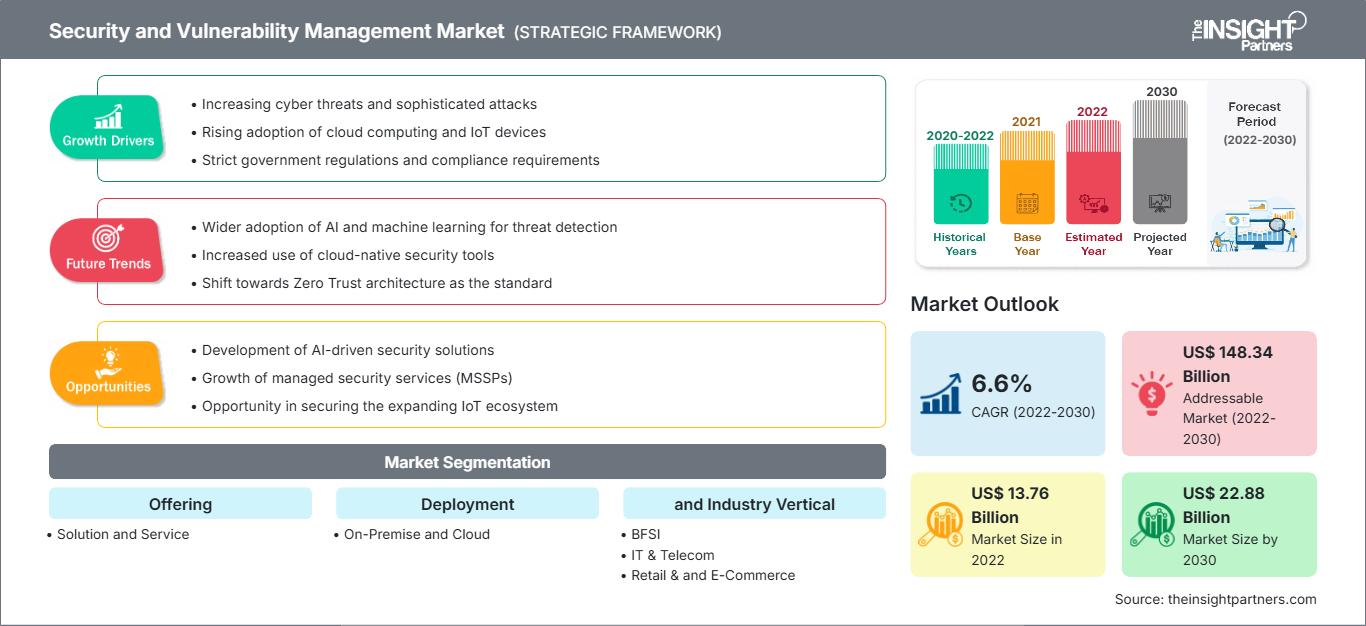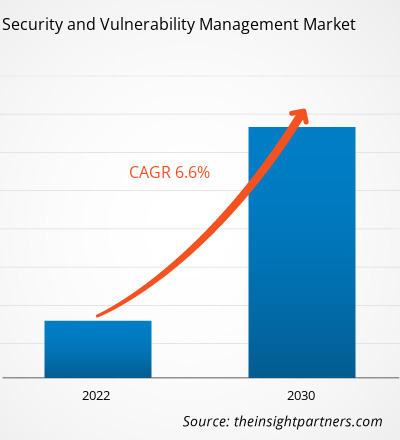[Forschungsbericht]Der Markt für Sicherheit und Schwachstellenmanagement soll von 13,76 Milliarden US-Dollar im Jahr 2022 auf 22,88 Milliarden US-Dollar im Jahr 2030 wachsen; der Markt wird voraussichtlich zwischen 2022 und 2030 eine durchschnittliche jährliche Wachstumsrate (CAGR) von 6,6 % verzeichnen.
Analystenperspektive:
Der Bericht enthält Wachstumsaussichten aufgrund der aktuellen Markttrends für Sicherheit und Schwachstellenmanagement und ihrer vorhersehbaren Auswirkungen im Prognosezeitraum. Die weltweit steigende Zahl von Cyberangriffen und Datenschutzverletzungen zählt zu den Faktoren, die den Markt stärken. Steigende Investitionen in KI-gestützte Lösungen und die Expansion der Sektoren BFSI und Gesundheitswesen dürften den Markt im Prognosezeitraum weiter ankurbeln. Strenge staatliche Vorschriften in Bezug auf Cybersicherheit und Datenvertraulichkeit kommen dem Markt ebenfalls zugute. Darüber hinaus dürfte die Integration moderner Technologien wie KI, ML, Datenanalysetools und Cloud-Speicher in den kommenden Jahren Wachstumschancen für den Markt für Sicherheit und Schwachstellenmanagement schaffen.
Marktübersicht:
Sicherheit ist das wertvollste Gut eines Unternehmens und erfordert sowohl Technologie als auch Schulungen. Schwachstellen entstehen durch Systemfehler, die zu unbefugtem Zugriff auf private Informationen führen können. Sicherheits- und Schwachstellenmanagement umfasst das Identifizieren, Klassifizieren, Mindern und Beheben von Schwachstellen in Netzwerk-Hardware oder -Software. Wichtige Daten aus der Schwachstellenanalyse werden von Sicherheitsteams genutzt, um Schwachstellen in ihren Netzwerken zu beheben und so die Risikobewertung und Bedrohungsminderung zu erleichtern. Ein Anstieg der Cyberkriminalität und steigende Investitionen in Cybersicherheitsprozesse dürften das Marktwachstum für Sicherheit und Schwachstellenmanagement in naher Zukunft vorantreiben.
Passen Sie diesen Bericht Ihren Anforderungen an
Sie erhalten kostenlos Anpassungen an jedem Bericht, einschließlich Teilen dieses Berichts oder einer Analyse auf Länderebene, eines Excel-Datenpakets sowie tolle Angebote und Rabatte für Start-ups und Universitäten.
Markt für Sicherheit und Schwachstellenmanagement: Strategische Einblicke

-
Holen Sie sich die wichtigsten Markttrends aus diesem Bericht.Dieses KOSTENLOSE Beispiel umfasst Datenanalysen, die von Markttrends bis hin zu Schätzungen und Prognosen reichen.
Markttreiber für Sicherheit und Schwachstellenmanagement:
Steigende Zahl von Cyberangriffen und Datenschutzverletzungen befeuert den Markt für Sicherheit und Schwachstellenmanagement
Laut einem im Februar 2024 veröffentlichten Bericht der AAG sind 43 % der britischen Unternehmen im Jahr 2022 mit Cyberangriffen konfrontiert, was einem Anstieg von ca. 32 % gegenüber 2020 entspricht. Dies treibt die Nachfrage der Verbraucher nach Lösungen und Diensten für Sicherheit und Schwachstellenmanagement zum Schutz sensibler Daten und kritischer Systeme vor Cyberangriffen an. Darüber hinaus werden diese Lösungen auch verwendet, um Schwachstellen zu identifizieren und zu beheben, was den Benutzern hilft, Risiken im Zusammenhang mit Sicherheitsverletzungen zu mindern und sensible Daten und Systeme zu schützen.
Segmentierung und Umfang des Berichts:
Die Marktanalyse für Sicherheit und Schwachstellenmanagement wurde unter Berücksichtigung der folgenden Segmente durchgeführt: Angebot, Bereitstellung und Branche. Basierend auf dem Angebot ist der Markt in Lösungen und Dienstleistungen segmentiert. Hinsichtlich der Bereitstellung wird der Markt für Sicherheit und Schwachstellenmanagement in Vor-Ort- und Cloud-Lösungen kategorisiert. Auf Branchenbasis ist der Markt in BFSI, IT & Telekommunikation, Einzelhandel und E-Commerce, Gesundheitswesen, Behörden und Versorgungsunternehmen und Sonstige unterteilt. Nach Regionen ist der Markt in Nordamerika, Europa, Asien-Pazifik (APAC), Naher Osten und Afrika (MEA) und Südamerika (SAM) segmentiert.
Segmentanalyse:
Basierend auf Branchenbasis ist der Markt für Sicherheit und Schwachstellenmanagement in BFSI, IT & Telekommunikation, Einzelhandel und E-Commerce, Gesundheitswesen, Behörden und Versorgungsunternehmen und Sonstige segmentiert. Es wird erwartet, dass das BFSI-Segment im Prognosezeitraum einen bedeutenden Marktanteil im Bereich Sicherheit und Schwachstellenmanagement halten wird. Das prognostizierte Wachstum dieses Segments wird der zunehmenden Digitalisierung und der steigenden Zahl von Cyberangriffen im BFSI-Sektor sowie deren starken Auswirkungen auf die Volkswirtschaften zugeschrieben. Laut Daten des Computer Emergency Response Team (CERT-In) war der Finanzsektor in Indien zwischen Januar und Oktober 2023 über 1,3 Millionen Cyberangriffen ausgesetzt, mit durchschnittlich 4.400 Angriffen pro Tag. Cybersicherheit wird für Finanzinstitute aufgrund der zunehmenden Digitalisierung im Finanzsektor immer wichtiger, was die Expansion des Marktes für Sicherheit und Schwachstellenmanagement erleichtert. Die Digitalisierung macht es Cyberangreifern leicht, Websites und Transaktionssysteme ins Visier zu nehmen.
Regionale Analyse:
Der geografische Umfang des Marktberichts für Sicherheit und Schwachstellenmanagement umfasst Nordamerika, Europa, den asiatisch-pazifischen Raum, den Nahen Osten und Afrika sowie Süd- und Mittelamerika. Gemessen am Umsatz hatte Nordamerika im Jahr 2022 den größten Marktanteil im Bereich Sicherheit und Schwachstellenmanagement. Wachsende Investitionen in KI-Technologie, ein steigendes Bewusstsein für Cyberbedrohungen, erhebliche Investitionen in Cybersicherheit sowie strenge Regeln und Vorschriften für die Finanzbranche treiben den Markt in dieser Region an. Die Region legt großen Wert auf die Einführung umfassender Sicherheitslösungen zum Schutz von Daten vor Cyberbedrohungen. Im Oktober 2023 wurden der Ausschuss für Auswärtige Angelegenheiten des Repräsentantenhauses und das Ausschuss für Innere Sicherheit und Regierungsangelegenheiten des Senats Opfer eines Cyberangriffs vietnamesischer Hacker, die versuchten, Spyware auf den Telefonen von Journalisten zu installieren. Solche Cyberangriffe wecken bei Verbrauchern die Nachfrage nach Lösungen zum Schwachstellenmanagement, um ihre sensiblen Daten zu schützen. Schwachstellenmanagement ermöglicht es Nutzern, ihre Systeme zu stärken, Daten zu schützen und Sicherheitsstandards einzuhalten.
Analyse der wichtigsten Akteure:
Microsoft Corp; International Business Machines Corp;, Hewlett Packard Enterprise Development LP; Qualys Inc; Tenable Holdings Inc; Rapid7; CrowdStrike Holdings Inc; Fortra, LLC; Skybox Security, Inc; und Cisco Systems Incare gehören zu den wichtigsten Unternehmen, die im Marktbericht für Sicherheit und Schwachstellenmanagement porträtiert werden.
Markt für Sicherheit und Schwachstellenmanagement
Die Analysten von The Insight Partners haben die regionalen Trends und Faktoren, die den Markt für Sicherheits- und Schwachstellenmanagement im Prognosezeitraum beeinflussen, ausführlich erläutert. In diesem Abschnitt werden auch die Marktsegmente und die geografische Lage in Nordamerika, Europa, dem asiatisch-pazifischen Raum, dem Nahen Osten und Afrika sowie Süd- und Mittelamerika erörtert.Umfang des Marktberichts zu Sicherheit und Schwachstellenmanagement
| Berichtsattribut | Einzelheiten |
|---|---|
| Marktgröße in 2022 | US$ 13.76 Billion |
| Marktgröße nach 2030 | US$ 22.88 Billion |
| Globale CAGR (2022 - 2030) | 6.6% |
| Historische Daten | 2020-2022 |
| Prognosezeitraum | 2022-2030 |
| Abgedeckte Segmente |
By Angebot
|
| Abgedeckte Regionen und Länder |
Nordamerika
|
| Marktführer und wichtige Unternehmensprofile |
|
Dichte der Marktteilnehmer im Bereich Sicherheit und Schwachstellenmanagement: Auswirkungen auf die Geschäftsdynamik verstehen
Der Markt für Sicherheits- und Schwachstellenmanagement wächst rasant. Dies wird durch die steigende Nachfrage der Endnutzer aufgrund veränderter Verbraucherpräferenzen, technologischer Fortschritte und eines stärkeren Bewusstseins für die Produktvorteile vorangetrieben. Mit der steigenden Nachfrage erweitern Unternehmen ihr Angebot, entwickeln Innovationen, um den Bedürfnissen der Verbraucher gerecht zu werden, und nutzen neue Trends, was das Marktwachstum weiter ankurbelt.

- Holen Sie sich die Markt für Sicherheit und Schwachstellenmanagement Übersicht der wichtigsten Akteure
Neueste Entwicklungen:
Die Marktprognose für Sicherheit und Schwachstellenmanagement kann den Akteuren in diesem Markt bei der Planung ihrer Wachstumsstrategien helfen. Die Marktteilnehmer setzen in hohem Maße auf anorganische und organische Strategien; einige der wichtigsten Entwicklungen sind nachfolgend aufgeführt:
- Im Oktober 2023 hat BackBox Software Inc. einen Network Vulnerability Manager-Dienst zur Verbesserung der Netzwerkautomatisierung eingeführt. Dieser neue Dienst unterstützt Benutzer bei der Netzwerkautomatisierung und bietet eine umfassende Lösung zur Verwaltung von Schwachstellen in Netzwerkinfrastrukturen.
- Im Oktober 2023 hat Hackuity die Version 2.0 seiner intelligenten, risikobasierten Schwachstellenmanagement-Plattform auf den Markt gebracht. Version 2.0 ist eine Plattform der nächsten Generation mit wesentlichen Verbesserungen, die Unternehmen im Umgang mit Risiken unterstützen. Die neue Version kombiniert den Schweregrad von Schwachstellen, Bedrohungsinformationen und einen einzigartigen Geschäftskontext und bietet Unternehmen einen messbaren True Risk Score (TRS).
- Im April 2023 startete Google LLC die Initiative Hacking Policy Council, um den Schwachstellenmanagementprozess zu stärken. Der Hacking Policy Council arbeitet mit Intel, Bugcrowd, Intigriti, HackerOne und Luta Security zusammen, um die Praktiken des Schwachstellenmanagements zu verbessern.
- Historische Analyse (2 Jahre), Basisjahr, Prognose (7 Jahre) mit CAGR
- PEST- und SWOT-Analyse
- Marktgröße Wert/Volumen – Global, Regional, Land
- Branchen- und Wettbewerbslandschaft
- Excel-Datensatz
Aktuelle Berichte
Verwandte Berichte
Erfahrungsberichte
Grund zum Kauf
- Fundierte Entscheidungsfindung
- Marktdynamik verstehen
- Wettbewerbsanalyse
- Kundeneinblicke
- Marktprognosen
- Risikominimierung
- Strategische Planung
- Investitionsbegründung
- Identifizierung neuer Märkte
- Verbesserung von Marketingstrategien
- Steigerung der Betriebseffizienz
- Anpassung an regulatorische Trends






















 Kostenlose Probe anfordern für - Markt für Sicherheit und Schwachstellenmanagement
Kostenlose Probe anfordern für - Markt für Sicherheit und Schwachstellenmanagement